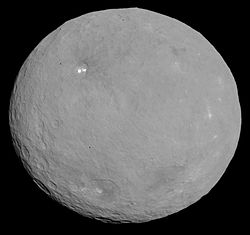
Ceres Polar Lander (CPL) is a European mission concept for a lander to Ceres that would search for biosignatures. [1] Published in 2008, the concept calls for a low-cost mission using reliable existing technology to complement other larger missions. [2] The original concept of the mission was to search for water ice and signs of life in permanently shadowed craters near Ceres' north pole. [2] However, with new information from the Dawn mission, it is now thought that water ice can be found on other locations on Ceres and that Occator crater may be a more desirable scientific target. [3]
If funded and launched, it would take about four years to reach Ceres, assuming a launch by a Soyuz rocket. [1]